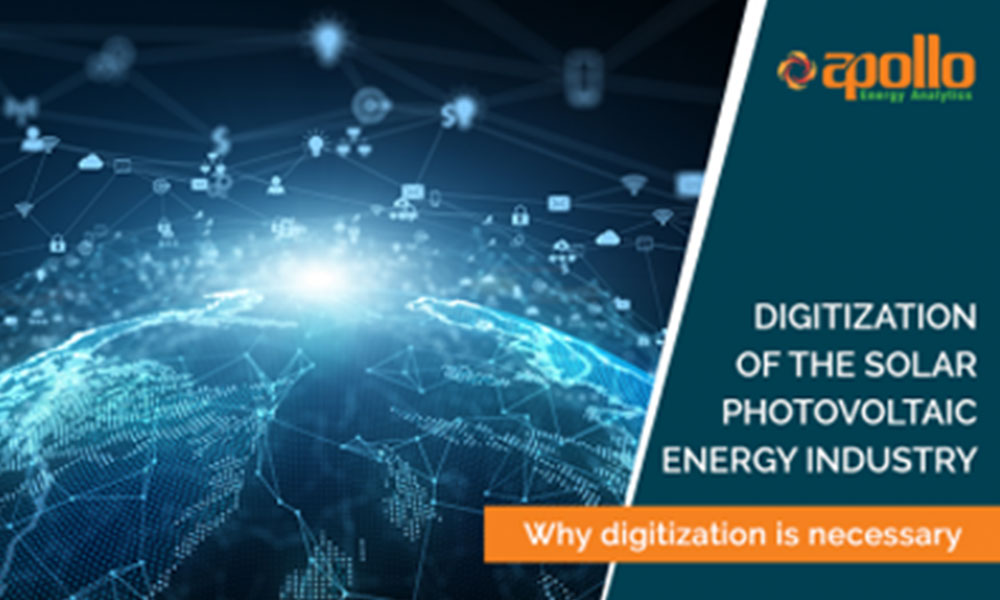
Just like every other industry, the solar photovoltaic energy sector stands to benefit from digitization significantly. This has become more prominent because of the sustainability concerns are compelling business to turn towards renewable sources and keep pace with the growing energy demands of the world.
Emerging technologies such as the Internet of Things, Cloud Computing, Solar Digital Twin or Digital Twin based analytics engines and Data Science are enabling energy companies to build smart grids, better manage energy generation, distribution and consumption, and reduce wastage. Digitization is probably the greatest empowering agent of that change, allowing energy companies to remotely monitor assets, unearth insights, and improve operational performance from a service and maintenance perspective.
In this blog, we talk about the importance of digitization and how ApolloTM – our digital twin enabled energy analytics solution is designed to solve business critical and complex problems in the Solar Space using our patented solar digital twin technology and advanced performance and health insights.
Why digitization is necessary?
With the world’s fossil fuels quickly depleting, economies across the globe are turning towards renewable sources such as solar photovoltaic energy – not just to meet the growing energy needs but also to eliminate greenhouse gas emissions and move to cleaner and efficient energy production. With the sun giving off far more energy to power every device on earth, it is imperative for energy companies to turn towards the digitization of the solar photovoltaic energy industry by using newer technologies such as digital twin for solar assets or digital twin and IoT platform enabled analytics solutions to get maximum returns from their investment.
Application of new-age digital technology such as cloud computing, IoT, big data analytics, solar digital twin – prominent being Microsoft azure digital twin, and blockchain to solar photovoltaic energy can not only help democratize but also decentralize energy supply. These capabilities can help energy companies build competitive advantage while capitalizing on the vast potential of new digital technology to increase deployment.
Digitization and adoption of cutting-edge tools and technologies can enable companies to:
- Build smart grids while increasing self-consumption rates, optimizing grid feed-in, and increasing the profitability of solar installations. According to reports, the global smart grid market is expected to reach $14.33 billion by 2022.
- Become agile at managing production better, resulting in improvements in distribution, management, as well as end-user consumption as a result
- Leverage the power of solar digital twin and data analytics to monitor solar grids proactively and identify and resolve issues before they impact production. It is estimated that the big data analytics market in the energy sector is expected to grow at a CAGR of 10.22%, during the forecast period, 2020-2025.
- Accurately forecast energy demand using simulations based on solar digital twin technology and optimize generation while paving the way for more efficient and reliable production and reducing wastage.
- Enable smart metering for quicker and more accurate billing and pave the way for better insights into energy consumption. It was estimated that by 2020, the EU Member States plan to roll out close to 200 million smart meters at a total potential investment of $50 billion.
- Reduce the time and cost spent on the installation of grids by using satellite mapping and remote design software. The costs can further be reduced by deploying digital replica of the solar power plants using digital twin for solar assets.
- Decrease payback time on solar installations and encourage faster and more widespread solar production using blockchain technology. Reports suggest blockchain in the energy market will reach $3 billion by 2025.
- Reduce the cost of solar electricity by increasing the capacity utilization and using latest storage technologies. A TERI study found that the cost of solar power will fall to Rs 1.9 per unit in India by 2030!
We also have an upcoming blog to highlight the Importance of Energy Analytics in Renewable Sector. If you are interested in digitizing your plants or solar assets using IoT, solar digital twin, data science and analytics, or are looking for an energy analytics solution, Contact us today.





